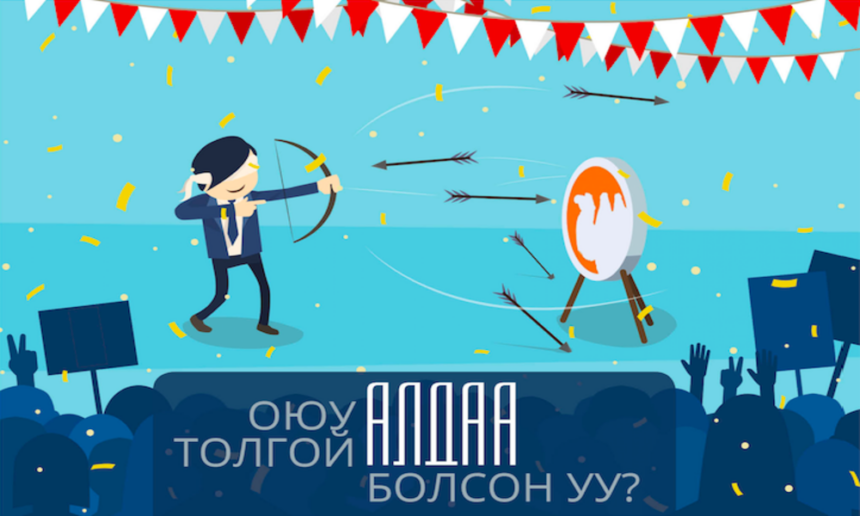Last Sunday (2 June 2019) the Mongolian National Broadcaster (MNB), which is the most viewed TV channel in the country, ran a program that suggested the Oyu Tolgoi project (OT) was a mistake, it isn’t mutually profitable, and there are learnings to be had. This program was based on the report that was presented to the Economic Standing Committee by the 12 MPs strong parliamentary working group who spent two months reviewing the massive project.
Whether it was a mistake or not, OT is a mega project that is carrying Mongolia’s economy on its back. However, we continue to see increased negative sentiment towards OT. Based on a metric called the Q Score, the gap between positive and negative sentiments appears to have consistently grown smaller from 2015 to 2019. There is now a need for the public to clearly understand what issues the Mongolian government and the investors are actually having differences on.
If Mongolian people don’t achieve clarity over OT and come to a shared stance, there are growing concerns that the election fever might cause OT to stop and push investors out of Mongolia. Rio Tinto faced similar circumstances a year ago in Indonesia and ended up walking away from the 40 per cent interest they held in the world’s second largest copper deposit Grasberg.
Oyu Tolgoi: The Reality
It has been exactly 10 years since Mongolia signed an agreement with foreign investors to commence mineral exploitation at the world’s third largest copper deposit Oyu Tolgoi (32 million tonnes of copper to mine). The project is jointly by the Mongolian government (34 per cent) and Turquoise Hill Resources (66 per cent), which is listed on the Toronto Stock Exchange. The fact that Rio Tinto owns 51 per cent of Turquoise Hill Resources has essentially allowed the deposit to be developed. Approximately 80 per cent of Oyu Tolgoi’s total value lies at 700-1,300 meters underground, while the remaining 20 per cent has been mined from their open pit mine.
OT started their copper concentrate exports in 2013, having commenced mining operations from the open pit mine. The preparations for developing the underground mine resumed in 2016, and it is expected that the underground production will start in 2021-2022. The parliamentary working group said that approximately 12 billion USD was invested in OT, of which 3 billion came from equity capital, 6 billion from a loan from 15 international banks, and 4 billion from project financing.
Since commencing production, OT’s sales reached 1.8 billion USD in 2014, 1.6 billion in 2015, 0.94 billion in 2017, and 1.2 billion in 2018, totaling at around 5.6 billion USD so far. This means the company is approximately worth 18 billion USD now (the combined value of total investment and sales revenue).
This sum is larger than Mongolia’s GDP, and one half – 9.1 billion USD – was spent in the country. As reported by OT, 6 per cent of this in-country spend went to their full-time employees and contractors in salaries, 19 per cent went to government organizations in taxes, fees, and other payments, and 75 per cent went to over 800 Mongolian businesses in payments for goods and services supplied to OT. The other half of the total spend was expended on purchasing fixed assets, working capital, management and administrative expenses, and other costs.
According to Erdenes OT, OT will not achieve their break-even point until 2029, after which the Mongolian government will spend 10 years repaying their equity loan of 1.07 billion USD along with its interest payments (541 million USD as of 2019), meaning Mongolia will start getting dividends from 2040.
Currently, OT is doing preparatory works to start the underground production. Over 16,000 are working at OT today, and 93 per cent of them are Mongolian nationals. However, when the underground production reaches its normal state by 2023, OT will have a permanent workforce of 6,000 people. If we count the suppliers in, approximately 45,000 Mongolians are currently working on this project. OT has made an investment of 400 million USD in the local communities, giving Khanbogd soum the foundation to become a modern town and enabling Umnugovi aimag to change its outlook and appearance. In addition, thousands of young Mongolians are obtaining skills and international qualifications in their profession and receiving on-the-job experience.
If you look at copper alone, OT exports 160,000 tonnes of copper annually in copper concentrate. This volume will grow 3-4 times when the underground production commences. By then, OT will presumably account for most of Mongolia’s government revenue. However, OT’s future has now become a contentious issue. As the 2020 election looms closer, the authorities are going through their political syndrome, with an increasing desire to appear as a ‘hero’ who stops the project, rather than making improvements.
OT is the largest project in Mongolia’s history, the first ever deal we’ve established with the Western world, and the first agreement that was signed without advice from Russian experts. Therefore, there is bound to be room for error. The people who established the agreement are being imprisoned and investigated for conflict of interest. Mongolia is suffering from a common trouble shared by developing countries that are dependent on natural resources.

Taking a helicopter view
OT is the largest project that is driving Mongolia’s economy. In order to implement the project, we’ve been making many agreements and also many revisions – the initial investment agreement, the shareholder agreement, the underground development agreement, the Dubai agreement and so on. It should be noted that the parliamentary working group strongly argued that there have been many flaws in the existing agreements.
There still are many issues and challenges, including that the investment agreement was signed without clear agreement on the feasibility study, which allowed the project costs grow twofold than initial estimate, and the investing party receives 3 per cent of the cost in the form of management fees, and the ongoing tax disputes due to the absence of alignment between parties on language associated with costs. The parliamentary working group included in their report that there was a tax violation of 3.2 trillion MNT in 2009-2015.
However, mutual trust can be achieved only when the both parties sit on the same table to discuss the issues, understand each other, agree on solutions and timeframes, and review the outcomes together. Only when there is mutual trust, there will be an effective, mutually beneficial working relationship.
The Mongolian party is now saying that, instead of co-owning a mega project and holding an interest, it is better to agree on higher taxes and royalties without owning shares. We need to start comparing this option against the current arrangement, look into possibilities of selling our 34 per cent interest (how to value, and who to sell), and determine how the taxing and payment rates can be changed.
Also, our civil society needs to work hard on improving transparency and publicly revealing direct and indirect interests of the authorities and politicians in connection to OT. When the civil oversight is improved, the impact of OT’s benefits will be felt more strongly to all Mongolian households. Only this way, natural resources can become a blessing, not a curse.
Having obtained a loan from those large international banks and having been the project manager of this massive project, Rio Tinto has no choice but to ensure insurance on all fronts. It is true that there is a need to make amendments to the OT deal or to clarify the above mentioned issues within the framework of the current agreements. The investor party has made a statement that they’re ready to enter negotiations to increase the benefits Mongolia receives.
Therefore, we can’t allow OT to be an election show again. We need to let the election pass, and then have the dialogue. Otherwise, if we cancel the agreement as some officials are suggesting, we would be shooting ourselves in the foot. There are neighboring countries who will be willing to purchase this project. On the other hand, the third neighbors and the banks who granted the loans are carefully observing if Mongolia will honor its agreed commitments.
We need to finish building to have a house, and – if we don’t finish and stop halfway – it will only become a pile. Let’s ensure OT becomes a house first. If OT becomes a pile, there won’t even be an accountable owner and we will be left with huge debts, including costs of going to international arbitration.
2019.06.05
Trans. by B.Amar







